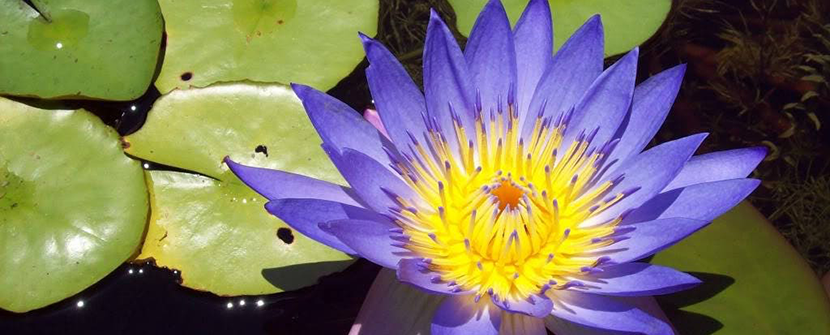Blue Lilly (Nymphaea caerulea), also known as Blue Lotus or Sacred Blue Lily, is a plant that grows in various parts of Africa and Asia, including Egypt, Ethiopia, and India. It has a long history of use in traditional medicine, as well as in religious and spiritual practices.
The plant is known for its distinctive blue flowers, which bloom on the surface of calm waters. Its petals contain psychoactive compounds, including aporphine and nuciferine, which are believed to have mild sedative and euphoric effects when consumed. Blue Lilly is often consumed in the form of tea, extract, or powder, and is sometimes smoked or vaporized.
Blue Lilly has been used for thousands of years in various cultures, including ancient Egyptian and Hindu traditions. In Egypt, it was associated with the god Nefertem and was believed to have healing properties. In Hinduism, it is associated with the god Vishnu and is considered a symbol of purity and enlightenment.
It is important to note that Blue Lilly is not approved for medicinal or therapeutic use by regulatory bodies in most countries, and its safety and efficacy have not been thoroughly studied. Therefore, it should be used with caution, and under the guidance of a qualified shaman or healthcare provider.
Physical description
Blue Lilly (Nymphaea caerulea) is a water lily that grows in various parts of Africa and Asia, including Egypt, Ethiopia, and India. Here are some physical characteristics of the plant:
Leaves: The leaves of the Blue Lilly are large and circular, measuring up to 40 cm in diameter. They are green and float on the surface of the water, with a wavy edge.
Flowers: The flowers of the Blue Lilly are the most distinctive feature of the plant. They are blue or bluish-white, measure up to 10 cm in diameter, and bloom on the surface of the water. The flowers have a sweet fragrance and close at night, reopening in the morning.
Roots: The roots of the Blue Lilly are large and tuberous, and are anchored in the muddy bottom of the water. They are light brown in color and can grow up to 2 meters in length.
Stem: The stem of the Blue Lilly is thick and fleshy, and grows up to 1 meter in length. It is rooted in the mud and grows up to the water's surface, where it produces leaves and flowers.
Overall, the Blue Lilly is a beautiful and unique plant with a striking blue flower that has been revered for its cultural and spiritual significance for thousands of years.
Best growing conditions
Blue Lily (Nymphaea caerulea), also known as Blue Lotus, is a water lily that is native to Egypt, but can now be found growing in other parts of the world. Here are some tips on how to grow Blue Lily in the best conditions:
Climate: Blue Lily prefers warm weather and can grow in both tropical and subtropical climates. It is important to keep the water temperature between 20-30°C (68-86°F) for optimum growth.
Water quality: Blue Lily grows well in clean water that is rich in nutrients. The pH of the water should be between 6.5-7.5, and it should have a low level of dissolved solids.
Lighting: Blue Lily requires plenty of sunlight for healthy growth. It should receive at least 6 hours of direct sunlight per day.
Soil: Blue Lily grows best in a mixture of clay and loam soil that is rich in organic matter. The soil should be heavy enough to hold the plant in place, but loose enough to allow for root growth.
Planting: Blue Lily should be planted in shallow water that is no more than 18 inches deep. The plant should be placed in a location that receives plenty of sunlight and has good water circulation.
Fertilization: Blue Lily benefits from regular fertilization during the growing season. A balanced fertilizer that is high in phosphorus and potassium is recommended.
By providing these growing conditions, you can help your Blue Lily thrive and produce beautiful blooms.
Modern medicinal uses
Blue Lily (Nymphaea caerulea) has been used for medicinal and spiritual purposes for thousands of years. In modern times, it has been researched for its potential medicinal properties. Here are some of the modern medicinal uses of Blue Lily:
Anxiety and Stress: Blue Lily has been studied for its anxiolytic and stress-reducing properties. It contains aporphine alkaloids that have been shown to have a calming effect on the nervous system, potentially reducing anxiety and stress.
Sleep disorders: Blue Lily has been traditionally used as a sleep aid. Studies have found that the plant contains compounds that may promote relaxation and improve sleep quality.
Pain relief: Blue Lily has been used traditionally for pain relief. Recent studies have shown that it may have analgesic properties due to the presence of alkaloids such as nuciferine and aporphine.
Anti-inflammatory: Blue Lily has been studied for its anti-inflammatory properties. It contains flavonoids, which have been shown to have anti-inflammatory effects in the body.
Antioxidant: Blue Lily has been found to have antioxidant properties due to the presence of flavonoids and other compounds. Antioxidants can help protect the body from oxidative stress and may have anti-aging effects.
While further research is needed to confirm the potential health benefits of Blue Lily, these studies suggest that it may have promising medicinal properties. As with any herbal remedy, it is important to speak with a healthcare professional before using Blue Lily for medicinal purposes.
Psychedelic effects
Blue Lily (Nymphaea caerulea), also known as Blue Lotus, is a plant that has been used for thousands of years for its psychoactive properties. It is native to Egypt and parts of Asia, and has been used in traditional medicine and spiritual practices.
The primary active compounds in Blue Lily are alkaloids such as nuciferine, aporphine, and others. These compounds are believed to be responsible for its psychoactive effects.
The effects of Blue Lily can vary depending on the dosage, method of ingestion, and individual sensitivity.
Some of the reported effects include:
Mild psychedelic effects: Blue Lily is known to produce mild psychedelic effects, including alterations in perception, mood, and thought processes. Users may experience visual distortions, enhanced colors, and increased sensory awareness.
Relaxation: Blue Lily is also known for its relaxing and sedative effects. It can help reduce anxiety and promote feelings of calmness and relaxation.
Euphoria: Some users report feelings of euphoria and well-being after consuming Blue Lily.
Enhanced creativity: Blue Lily is said to enhance creativity and can be used as an aid in creative pursuits such as writing, painting, or music.
Increased sexual arousal: Blue Lily is also known to have aphrodisiac effects and can enhance sexual arousal and performance.
It is important to note that the effects of Blue Lily can vary from person to person and can also be influenced by the setting and mindset of the user. It is recommended to start with a low dose and gradually increase if needed, and to always use caution when trying new substances.
Indigenous use and ceremonies
Blue Lily (Nymphaea caerulea), also known as Blue Lotus or Sacred Blue Lily, has a rich history of use in indigenous cultures, particularly in Ancient Egypt and India. It was considered a sacred plant and was often used in religious ceremonies, as well as for its medicinal properties.
In Ancient Egypt, Blue Lily was associated with the god Nefertem and was often depicted in paintings and carvings. It was believed to have powerful psychoactive properties and was used to induce a state of heightened awareness and altered consciousness.
In India, Blue Lily was used in Ayurvedic medicine for its calming and sedative effects. It was also used in religious ceremonies and was considered a symbol of the divine.
Today, Blue Lily is still used in traditional medicine and spiritual practices by some indigenous communities. It is believed to have a calming and relaxing effect on the body and mind, and is often used to help alleviate anxiety and stress. It may also be used as a sleep aid and to promote lucid dreaming.
In ceremonial contexts, Blue Lily may be brewed into a tea or smoked, and is often used in conjunction with other sacred plants and herbs. It is typically consumed in a quiet and contemplative setting, with the intention of facilitating a deeper connection with the spiritual realm.
Overall, Blue Lily holds a special place in many indigenous cultures and is revered for its powerful effects on the mind, body, and spirit.
Cautions and common sense
Blue Lily (Nymphaea caerulea) should be used with caution and under the guidance of a qualified healthcare professional or experienced practitioner.
Dosage can vary depending on the individual and the intended use of the plant. As a general guideline, it is recommended to start with a small dose and gradually increase as needed.
For a tea, a common starting dose is 1-2 of dried Blue Lily per cup of hot water. The tea can be consumed up to three times a day.
For a smoking blend, a common starting dose is 0.2-0.5 grams of dried Blue Lily per joint or bowl. It is important to note that smoking Blue Lily can be harsh on the lungs and is not recommended for individuals with respiratory conditions.
Possible side effects of Blue Lily may include dizziness, nausea, and gastrointestinal discomfort. It is not recommended for use during pregnancy or while breastfeeding.
Blue Lily may also interact with certain medications, particularly those that affect the central nervous system. It is important to speak with a healthcare provider before using Blue Lily if you are taking any medications or have any underlying medical conditions.
Overall, while Blue Lily has a rich history of use in traditional medicine and spiritual practices, it should be used with caution and under the guidance of a qualified healthcare professional or experienced practitioner.


